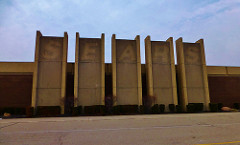It wasn’t so long ago that I was a teenager spending free time socializing with my friends at our local, bustling mall. Our mall was shaped like a wagon wheel with an anchor department store at the end of each spoke, and kiosks and a carousel in the hub. We would browse store by store, up and down each spoke, rarely coming upon any empty store fronts. Fond memories of extensive teenage wardrobes aside, malls do not hold the same appeal they used to.
Nicholas Eckhart/flickr/2014
More and more, mall experiences like this seem to be falling off. Visit former malls in southern Indiana or Ohio and you’ll see eerily abandoned malls. Anchor stores continue to close, and this negatively affects the prosperity of stores that feed off the traffic. As traditional anchors shut down, retailers are more likely to follow the TJ Maxx or Marshall’s model, and replacements will be outlets such as Nordstrom Rack and discount Macy’s. Premier Outlet centers have also been popping up more and more to fill the void. Experts expected around 300 malls would close by 2025. Stores like The Limited have completely shut down their brick and mortar presence, and stores like Aeropostale, Wet Seal (no! where do teenagers buy their red glitter hairspray now?), and PacSun have filed for bankruptcy.
Nicholas Eckhart/flickr/2013
What will become of these shells of former retail greatness? Real estate is real estate, and as such, some have been converted to condos. Others have new lives as office buildings, medical centers, greenhouses, and schools.
How are malls in your area? What changes to retail commercial space have you seen?
Keep in touch and informed: Follow Information Services on Twitter (@asknar) and Facebook (NAR Information Services). Contact us next time you have a research project or question toll-free at 800.874.6500, informationservices@realtors.org, Skype narinfoservices, or text AskNAR to 66746.
Powered by WPeMatico



